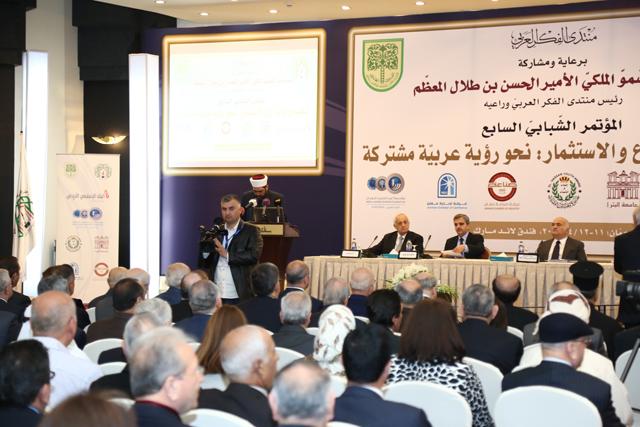You are here
Economic charter highlights potential for inter-Arab partnerships
By Dana Al Emam - Aug 10,2015 - Last updated at Aug 10,2015

HRH Prince Hassan, president of the Arab Thought Forum, speaks at a ceremony in Amman on Sunday to launch the Arab Economic Charter (Petra photo)
AMMAN — The Arab Thought Forum (ATF) on Sunday launched the Arab Economic Charter, an analytical study of the region’s economies that looks into possibilities of future inter-Arab partnerships.
In three chapters, the charter discusses the situation of Arab economies, the emergence of the national state and the collective Arab economic uprising to achieve sustainable development.
Prepared by intellectuals and academics from Jordan and the Arab world, the charter is a call for adopting “rational” national and Arab economic decisions that neutralise political interests, preserve economic accomplishments and build on them.
Speaking at the launch ceremony, HRH Prince Hassan, ATF president, said Arab countries must find the ability to overcome a past of division and colonisation and start acting as a united economic bloc.
“There is still a chance to redirect the latent Arab potential towards building and not waste it or leave it fair game for extremism,” he said in his address to an audience of senior officials, opinion leaders, academics and diplomats.
The prince added that oil importing Arab countries have great human and intellectual resources that can contribute to a larger and more just economic development in the region, if managed properly; but the gap remains in the weak connection between these potentials from one side, and industry and production from another.
He pointed to the migration of Arab intellectuals and investments as a major issue facing countries in the region, stressing that development cannot be achieved without cooperation and integration between qualified Arabs inside and outside the Arab world.
The charter is an attempt to enable Arab people to take the initiative in their development options, set their own plans for the future they want and move towards a productive economy that allows their countries to unite in a single block, said ATF Secretary General Mohammad Abu Hammour.
The former finance minister said a “realistic” approach is required when dealing with Arab economies to address the root of development problems, highlighting the need to strengthen national economies as a prerequisite for any inter-Arab economic partnership.
“The future cannot be built on a national level… no country can be isolated from its surroundings,” he noted, adding that economy is the cornerstone of Arab independence.
Senator Jawad Anani, a former Royal Court chief and several-time minister, and former education minister Ibrahim Badran spoke about the pillars of the charter.
Anani said the charter challenges the common view in literature that categorises Arab countries into two groups: one with excess capital, and the other with excess labour force, adding that poverty and unemployment are spread across all Arab countries in various percentages.
He noted that unemployment rates among young Arabs are double the international rates, highlighting a weakness in Arab countries’ abilities to provide jobs for young people and encourage women to participate in the labour market.
Anani said the decision-making process in the Arab world ignores alternative solutions to problems under study and does not present them in a scientific manner, adding that decision makers tend to disregard public concerns.
For his part, Badran said the charter calls for having the national state and its economy as the foundation for any Arab cooperation and that the similarities between Arab states, despite the differences in the type of resources, should be the basis for partnerships, not assistance.
Economy-based inter-Arab partnerships should include the public and private sectors, as well as civil societies and academia for a comprehensive partnership, he added.
Related Articles
AMMAN — Enhancing the efficiency of educational systems in Arab countries and creating a better synergy between educational outcomes and lab
AMMAN — Deputising for His Majesty King Abdullah, Deputy Prime Minister and Minister of State for Economic Affairs Jafar Hassan on Tuesday i
Jordan on Sunday underlined the significance of speeding up efforts for formulating an Arab Customs Union to boost inter-Arab trade.



















